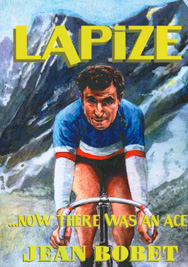


|
Paperback |
|
LAPIZE … NOW THERE WAS AN ACE 2010 is the centenary of the introduction of the Pyrenees into the Tour de France route. It was a contentious decision at that time to send riders on their primitive bicycles into the high mountains. How Tour organiser Henri Desgrange was tricked by his assistant, Georges Steines, into agreeing to direct his riders over 2,000-metre cols is one of the great legends of Tour history. The 1910 race was won by the French champion Octave Lapize, who added to the controversy on the top of the Col du Tourmalet by shouting out to the Tour officials, ‘Vous êtes des assassins! Oui, des assassins!’ – ‘You are murderers! Yes, murderers!’ Author, Jean Bobet, writes: Back in Villiers-sur-Marne, you couldn’t find Octave Lapize at the café any more. We knew he had been killed in the war, the 1914-18 one. People even said he died a hero. The Café Lapize belonged to the champion’s father. One day, I ducked under the arbour at the entrance and went inside. Across the large room, I came face to face with the great Octave Lapize, in a large pastel drawing on the wall, resplendent in his French champion’s tricolour jersey. I was looking at the portrait of a true aristocrat. An inscription underneath read “Winner of the Tour de France, Paris-Roubaix (three times), Paris-Brussels (three times).” I spent fifty years thinking about Octave Lapize. Then, one day, I decided to follow his tracks and tell his story. Thanks to him, I experienced the golden age of cycling at the beginning of the twentieth century. The Lapize years. “Biographies of great riders abound on the world’s cycling bookshelves, but what places this on the shelf above those, is the manner and ability of its author…Originally written in French and beautifully translated by Adam Berry, Bobet’s use of language sparkles throughout the 159 pages. Brian Palmer www.thewashingmachinepost.net |